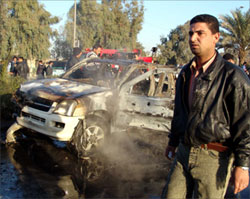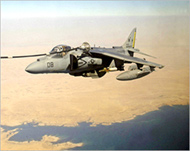Untitled Document
 |
|
Predators are used for offensive as well as monitoring missions
|
The latest figures released by US Central Command show a dramatic rise
in the number of air raids carried out in Iraq.
Although receiving little coverage in the US media, the US air force, navy
and marines have flown thousands of missions backing up US ground troops in
Iraq this autumn.
According to figures provided by Central Command Air Force's public affairs
office, the monthly number of air missions, including refuelling and other support
flights, grew from 1111 in September to 1492 in November 2005.
The number of US air raids increased particularly in the weeks leading up to
last Thursday's election, from a monthly average of about 35 last summer to
more than 60 in September and 120 or more in October and November.
News reports and the public have focused mainly on ground action by the army
and marines, but a variety of US aircraft are carrying out attacks daily. They
include frontline air force and navy fighters as well as marines attack planes.
American and allied refuelling, transport and surveillance planes are also
flying.
US raids have included attacks using unmanned Predator aircraft armed with
Hellfire missiles.
The air raids have been largely in the west of Iraq, hitting regions where fighters
opposed to the US presence remain strong. Targets include Balad, Ramadi and
the vicinity of Baghdad, according to the US military's Central Command.
Central Command specifically mentioned a raid on Iraq's election day, 15 December,
by an F-16 fighter fired precision-guided munitions at an access road used by
fighters near Baghdad.
Arial onslaught
These figures pale in comparison to the aerial onslaught that was unleashed
at the start of the war in March 2003, when B-2, B-1 and B-52 bombers were part
of the offensive.
Even so, air might has remained a part of the arsenal that US forces routinely
use in what is now largely a ground fight.
 |
|
US air raids increased particularly
in the weeks before the election
|
The anti-US fighters have had little luck defending against air attacks. Yet it
is difficult to know how effective the strikes have been in killing them, disrupting
their movements or improving security for ordinary Iraqis.
The nascent Iraqi air force has no offensive strike capability at the moment.
Late last month the crew of one of Iraq's three US-donated C-130 cargo planes
flew a mission without a US instructor on board for the first time.
According to brief reports provided by Central Command Air Force officials,
recent attacks have included a Predator firing a Hellfire missile on 12 December
"with successful effects" at an "improvised explosive device
location" near the town of Haditha.
A 7 October report said an F-16 expended 1000 20mm cannon rounds in attacks
against fighters near the town of Haqliniya.
Background role
The role of the Predator is not secret but has been largely lost in the clutter
of violence on the ground.
At least five times this month an unmanned Predator flown remotely by airmen
at flight consoles at a base in Nevada has struck targets in Iraq, mostly in
fighters' strongholds in western al-Anbar governorate.
General Michael Moseley, the air force chief of staff, said last Tuesday that
Predators were attacking targets in either Iraq or Afghanistan almost every
day.
In a more common surveillance role, unarmed Predators are used in Iraq to monitor
roads where fighters might plant bombs. They transmit live images to intelligence
units that share the information with ground troops.
The aircraft used most frequently for strike missions in Iraq are F-16 and
F-15 fighters based at an air base in Balad, north of Baghdad; navy F-18 fighters
launched from a US aircraft carriers in the Persian Gulf, and marine F-18s from
al-Asad air base in western al-Anbar governorate.

